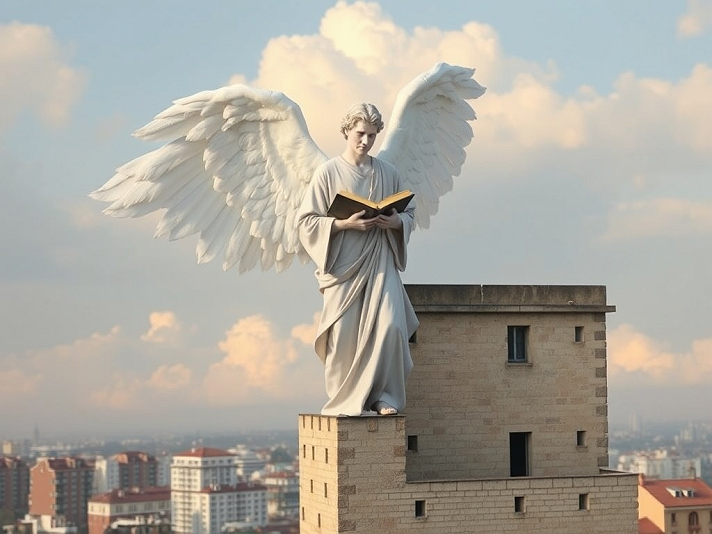The Iconography and Symbolism of the Angelic Reader: A Visual and Theological Analysis
The Iconography and Symbolism of the Angelic Reader: A Visual and Theological Analysis
The series of images presented depicts a recurring motif: a winged angelic figure, robed in flowing white garments, standing atop architectural structures while intently reading an open book. These visuals, rendered with a blend of hyper-realism and ethereal stylization, evoke classical religious art traditions while incorporating modern digital aesthetics. At first glance, they appear as statuesque monuments or divine apparitions perched on buildings ranging from ornate historical edifices to contemporary urban rooftops. This essay will thoroughly explore the composition, symbolism, historical context, potential origins, and interpretive layers of these images, treating them as a cohesive set that invites reflection on themes of knowledge, guardianship, divinity, and human aspiration.
The core visual element across all images is the angel itself—a humanoid form with expansive, feathered wings that dominate the frame, symbolizing flight, transcendence, and a connection between the earthly and the heavenly. The wings are meticulously detailed, with individual feathers catching light to create a sense of texture and movement, even in static poses. This attention to plumage draws from biblical and apocryphal descriptions of angels, such as in the Book of Isaiah (6:2), where seraphim are depicted with six wings, or in artistic representations like those in Renaissance paintings by artists such as Raphael or Michelangelo. Here, the wings are simplified to two large pairs, emphasizing majesty over complexity, and they often span wider than the figure's body, framing the scene like a protective canopy or a proclamation of authority.
The angel's attire further reinforces this celestial identity: loose, draped robes in shades of white or pale gray, reminiscent of ancient Greco-Roman togas or biblical priestly garments. These robes flow naturally, billowing slightly as if stirred by an unseen wind, adding dynamism to otherwise serene compositions. In several images, the fabric appears semi-translucent or luminous, glowing against the sky and suggesting purity, holiness, or an inner divine light. The figures are barefoot in most cases, grounding them symbolically on the human-made structures while elevating their spiritual status—bare feet evoke humility, pilgrimage, or direct contact with the sacred, as seen in Exodus 3:5 where Moses is instructed to remove his sandals on holy ground.
Central to every image is the open book held reverently in the angel's hands. The book is positioned at chest level, with pages spread wide, and the figure's gaze is invariably downward, absorbed in reading. This act of contemplation imbues the scene with intellectual and spiritual depth. The the book represents sacred scripture, wisdom, or divine revelation. In Judeo-Christian iconography, angels are frequently portrayed as messengers or scribes; for instance, the Archangel Gabriel delivers announcements with a scroll or book, while in Islamic tradition, angels record human deeds in ledgers. Here, the book's golden or reddish hues in some variants contrast with the angel's pallid form, drawing the eye and symbolizing enlightenment amid a mundane world. The text within is illegible in most images, intentionally blurring the line between specific doctrine and universal knowledge, allowing viewers to project their own interpretations—perhaps the Bible, the Torah, the Quran, or even secular texts like philosophical treatises.
The settings amplify the thematic tension between the divine and the profane. The angels perch on pedestals or ledges atop grand buildings: some resemble Gothic cathedrals or Renaissance palaces with arches, domes, and ornate balustrades; others are modern high-rises or nondescript urban structures overlooking cityscapes at dawn, dusk, or daylight. This juxtaposition places the celestial being in a liminal space—literally on the edge, overlooking humanity's creations. The backgrounds feature expansive skies with scattered clouds, often bathed in warm golden light or cool blue tones, evoking moments of transition (sunrise for hope, sunset for reflection). In urban scenes, distant lights or hazy skylines hint at human activity below, contrasting the angel's solitude and focus. This architectural variety suggests the images are not tied to a single location but represent a universal archetype: divine oversight in diverse human contexts, from historical reverence to contemporary anonymity.
Stylistically, these images bear the hallmarks of digital art generation, likely produced by AI tools such as Midjourney, DALL-E, or Stable Diffusion, given their polished hyper-realism, consistent lighting effects, and subtle surreal elements (e.g., impossibly large wings on realistic figures). The figures themselves vary slightly in appearance—some elderly with beards, evoking wisdom and antiquity; others youthful or androgynous, suggesting timelessness; a few muscular or adorned with necklaces, adding layers of strength or ornamentation. Hair ranges from flowing white locks to short-cropped styles, and skin tones are uniformly pale, almost marble-like, reinforcing a sculptural quality. This variability prevents monotony and invites scrutiny: are these iterations of the same archetype, or distinct angelic entities? The statue-like rigidity in poses—heads bowed, hands steady—contrasts with the organic wings and robes, creating a tension between immobility (eternal vigilance) and potential action (imminent flight or proclamation).
Theologically and culturally, the motif draws heavily from the concept of guardian angels or watchers. In the Book of Enoch (an apocryphal text influential in Jewish and Christian mysticism), "Watchers" are angels tasked with observing humanity, sometimes recording deeds in books of life or judgment. This reading angel could symbolize the accumulation of knowledge or the judgment of souls, perched high as if surveying and inscribing the world's story. In a broader sense, it echoes the Library of Babel or Akashic records—cosmic repositories of all knowledge. The urban placements modernize this, perhaps commenting on contemporary society's disconnection from spirituality amid skyscrapers and technology. The angel reads undisturbed, a beacon of contemplation in a chaotic world, urging viewers to pause and reflect.
Interpretively, these images can be read on multiple levels. Literally, they might depict public art installations or conceptual sculptures, though no real-world equivalents perfectly match (similarities exist with statues like the Angel of the North in England or Victorian cemetery angels, but none with such prominent books and wings on building tops). More plausibly, they are AI-generated artworks exploring themes of faith in the digital age. The series' repetition—with minor variations in lighting, architecture, and figure details—mirrors iterative AI prompting, where users refine outputs to perfect an ideal. This meta-layer adds irony: machines "creating" images of divine readers, questioning who truly holds knowledge in an era of artificial intelligence.
Symbolically, the angel embodies the pursuit of wisdom amid elevation. Standing on high, it is removed from earthly turmoil yet engaged with a text, suggesting that true understanding requires detachment. The book as a focal point critiques modern distractions; in a world of screens and scrolling, the angel models deep, focused reading. For religious viewers, it affirms divine presence in everyday landscapes; for secular ones, it represents intellectual guardianship or the enduring human quest for meaning.
In conclusion, these images form a poignant visual essay on the intersection of the sacred and the structural. Through their angelic readers, they weave threads of ancient iconography into modern contexts, prompting questions about vigilance, knowledge, and transcendence. Whether viewed as art, allegory, or digital experiment, they compel thorough contemplation—much like the figures themselves, absorbed in their eternal texts atop the world's rooftops.

































 The Sunday Circle
The Sunday Circle